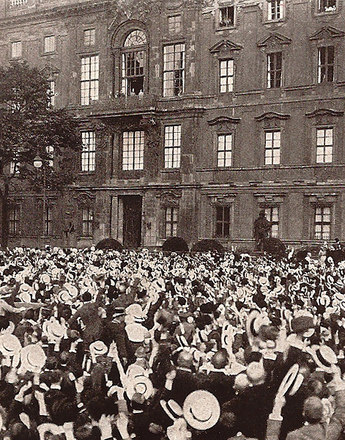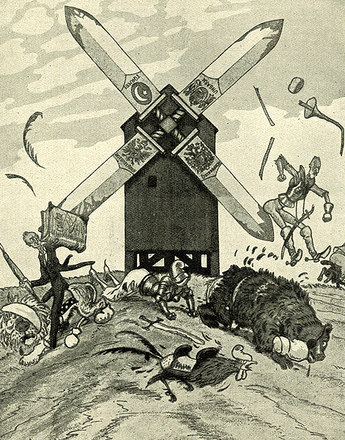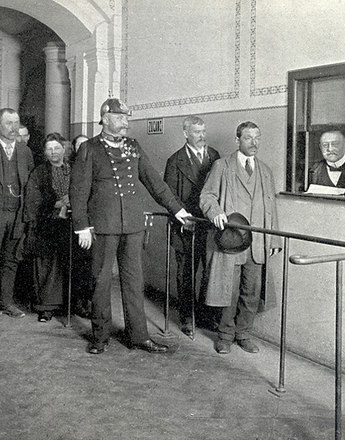-

“Off to Serbia!” The 16th Infantry Regiment is posted to Serbia, photo 1914
Copyright: Wien Museum
-

“Painful operation”, propaganda postcard
Copyright: Wien Museum
-

“In a thorough cleaning, even this vermin has to be eradicated“, propaganda postcard
Copyright: Wien Museum
-

“The boy goes to war”, from the “War memories 1914-15” postcard album
Copyright: Schloß Schönbrunn Kultur- und Betriebsges.m.b.H.
Partner: Schloss Schönbrunn Kultur- und Betriebsges.m.b.H.
Chauvinistic rhetoric and martial sabre-rattling dominated the critical days of July 1914. The belligerent vocabulary of the political elites struck a chord in hearts and minds all over Europe.
‘If anyone has something to say, let him come forward – and be silent!’
Quoted from Christian Wagenknecht (ed.), Weltgericht I: In dieser großen Zeit (Frankfurt am Main, 1988), p. 9
‘I know no party any more: I only know Germans.’
Quoted from Wolfdieter Biehl, Der Erste Weltkrieg 1914–1918. Chronik – Daten – Fakten, (Vienna/Cologne /Weimar, 2010), p. 64
Although the ardent martial fervour that overcame large parts of Europe in the summer of 1914 is hardly comprehensible to us today, there were several reasons for the positive image that war possessed in the popular mind of the time. Firstly, nobody in Europe had any experience of the kind of industrialized ‘war of the masses’ that the First and Second World Wars turned out to be. There was little knowledge of the horrors of war, especially now that the last large-scale European wars (such as the Franco-Prussian War of 1870/71) were long past. Although there had been wars in Europe in the decades around 1900, for the great powers these had ‘only’ been localized proxy wars in the colonies or on the periphery of Europe (the Balkan Wars of 1912 and 1913).
At the beginning of the war there was enormous patriotic euphoria in all the countries concerned. The capitals witnessed patriotic rallies at which the most significant participating group was the urban middle class. The streets resounded with cries for a national closing of ranks and for a truce in which internal tensions and conflicts were to be set aside in the interest of ‘Burgfriede’ (‘peace within the castle precincts’). Rich and poor, right-wingers and left-wingers: the whole ‘national community’ was now to pull together for a common goal. This well-orchestrated vision of the nation as a collective body is referred to by historians as the ‘August experience’.
In parallel with the military mobilization there was also a mobilization on the level of inner values. Existing prejudices were intensified and new stereotypes of the enemy created. The Habsburg Monarchy presented itself as a superior ‘bulwark of civilization’, whose ‘honour’ had to be defended against the ‘barbarian East’, meaning the Serbs and the Russians. The alliance with the German Empire was continually invoked, principally with calls for the blind faith summed up in the watchword ‘Nibelungentreue’ (‘Nibelung loyalty’); and the rest was done by phenomena typical of the time such as social Darwinism (‘Only the strongest survive!’), the glorification of force, and the cult of manliness (‘soldier’s honour’).
Many of the actions described in the press as ‘spontaneous expressions of the people’s will’ were in fact engineered or directed by the government or the military. There was very much less questioning of state orders than there is today. In most Central European states a patriarchal authoritarian state meant that large parts of the population (women, the poor, and others) were totally excluded from the decision-making process. Hardly any critical voices were raised in the media, because censorship came into operation as soon as the war broke out, extending firm control over the newspapers and other channels for the expression of public opinion.
Nevertheless, there were clear signs of scepticism and of reservations concerning the war and its consequences. Peace initiatives were mounted to hold back the tide of war, with peace rallies taking place in various towns. Not everyone identified to the same extent with the war goals prescribed by the state authorities as necessary for the nation.
But the war was also seen as a catalyst in the fight against traditional social systems that were perceived to be unjust and in the battle against the decadence of the fin-de-siècle elites. The Social Democrats, for example, were in principle in favour of maintaining peace, but at the same time saw the outbreak of war as a chance for a ‘just struggle’ against anti-democratic regimes in Europe.
The special structure of the Habsburg ‘state of many peoples’ meant that there was another dimension to the whole scenario, that of nationalism, for it was among the two largest national groups, the Germans and the Magyars, that the war euphoria was at its greatest. This was in a sense paradoxical, as the war aims of the Habsburg Monarchy were in fact in opposition to German and Magyar national interests. The gaining of further Polish or southern Slav territories would have increased the proportion of Slavs in the Monarchy as a whole, thus posing a further threat to German and Magyar hegemony.
Nevertheless, the other nationalities were likewise seized by general wave of patriotic feeling. The official positions of the Czech, Polish and southern Slav national representatives showed that they were not really sure what to do. Although they initially hastened to make public statements of loyalty to the Habsburg Monarchy and its war aims, they gradually drifted into a state of political passivity. At the beginning of the war there was no active political resistance to the Monarchy’s war policy.
Translation: Peter John Nicholson
Bihl, Wolfdieter: Der Erste Weltkrieg 1914–1918. Chronik – Daten – Fakten, Wien/Köln/Weimar 2010
Hamann, Brigitte: Der Erste Weltkrieg. Wahrheit und Lüge in Bildern und Texten, 2. Aufl., München 2009
Hanisch, Ernst: Der lange Schatten des Staates. Österreichische Gesellschaftsgeschichte im 20. Jahrhundert [Österreichische Geschichte 1890–1990, hrsg. von Herwig Wolfram], Wien 2005
Hirschfeld, Gerhard/Krumeich, Gerd/Renz, Irina (Hrsg.): Enzyklopädie Erster Weltkrieg. Aktualisierte und erweiterte Studienausgabe, Paderborn/Wien [u.a.] 2009
Leidinger Hannes/Moritz, Verena: Der Erste Weltkrieg, Wien [u.a.] 2011
Rauchensteiner, Manfried: Der Erste Weltkrieg und das Ende der Habsburgermonarchie 1914–1918, Wien u. a. 2013
-
Chapters
- The enthusiasm for the war
- ‘Brothers in arms’: Austria-Hungary and Germany as partners and allies
- Front lines – The course of the war 1914–16
- Italy enters the war
- The impact of the war on civilian society
- The accession of Emperor Karl
- The Sixtus Letters – Karl’s quest for a way out
- Karl’s bid for freedom
- The Russian Revolution and its consequences
- 1917 – The turning point






